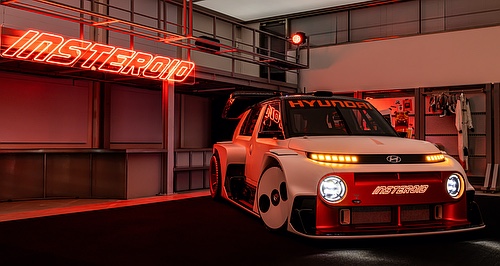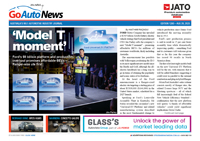Make / Model Search
Future models - Hyundai - Inster - InsteroidHyundai Insteroid teases cheaper "N" EVAWD Ioniq 5 N running gear is disguised beneath reprise of 1980s rally-car styling2 Apr 2025 By TOM BAKER in SEOUL Hyundai has taken the wraps off a radical, performance-focused concept car based on its upcoming Inster small electric SUV—with the ‘Insteroid’ previewing the potential of a more affordable EV for the N high-performance sub-brand.
GoAuto was present at Hyundai’s private reveal event in South Korea for the Insteroid ahead of the 2025 Seoul Mobility Show.
With a brief total development time of just 12 months—of which just six months elapsed between the first sketches and the one-off prototype—the rally-inspired Insteroid initially presents as an outlandish design study, but serious mechanicals sit just beneath the box fender-festooned skin.
Like N division’s very similarly-sized RN24 prototype revealed in December 2024, the Insteroid borrows its dual-motor electric powertrain, all-wheel drive (AWD) and e-GMP architecture from the Hyundai Ioniq 5 N ($110,383 + ORC) while reimagining the components in a smaller and lighter package.
Hyundai was at pains to note that the Insteroid is not an ‘N’ concept, and that N division were not involved in the exterior or interior design process (which was led by Hyundai’s European design centre) but the new concept is clearly informed by the performance arm’s priorities.
Speaking with GoAuto at the reveal event in the industrial Seoul neighbourhood of Seongdong, Hyundai Motor Europe exterior design manager Nicola Danza confirmed the Insteroid’s utilisation of the Ioniq 5 N’s 478kW/740Nm drivetrain and 84kWh usable battery.
While some standard Inster body panels were used, the Insteroid uses a stretched wheelbase when compared to the series Inster, in order to accommodate the larger battery (the Inster offers just 49kWh) as well as enormous 21-inch wheels that sit entirely outboard of the standard track.
Hyundai’s Rüsselsheim, Germany-based exterior and interior designers led the styling effort for Insteroid, which is fully functional and not just a shell—but the valuable nature of the one-off car means that, while it is fully capable of exploiting the built-in Drift Mode, test drivers treat it with care.
“There is a proper powertrain here, from our performance brand. We use the Ioniq 5 N e-GMP platform, shortened in the suspension area,” Danza said. “If there is something I’ve learned in all my years at Hyundai, it is that if there is a company crazy enough to (build the Insteroid), it could be Hyundai.”
Externally, the Insteroid presents as a homage to iconic 1980s hot hatches. The white-and-orange bodywork sits astride 21-inch alloy wheels shod in staggered, 295-section front and 345-section rear Pirelli tyres. An aggressive wide body, vented wheel arches, and a visible sound generator near the rear-set charge port complete the assertive visual packaging.
Inside, the Insteroid is trimmed with recycled materials, and features lightweight racing seats with in-built harnesses. A motorsport-style steering wheel houses round digital gauges, while a prominent handbrake next to the driver’s pew activates Drift Mode.
The Insteroid also builds on the synthetic noise functionality of the Ioniq 5 N, this time making the feature a more prominent part of the design—effectively replacing a visible exhaust outlet.
“We realised (sound) was a very good idea to carry on. This is the next step. You don’t need to hide (where the sound comes from). You can even offer it in a better location where you can be clever by using graphics. Where there is a round (tail) lamp you can exchange the lamp and put in speakers,” Danza said.
Despite appearances, Hyundai has held back from officially naming the Insteroid as a member of the N family. While the Insteroid shares many visual, powertrain and scale similarities with the N division’s compact RN24 prototype, Danza said the projects are separate—at least at face value.
“(RN24 and Insteroid) are two separate types of products. “N” produces real things, serious performance cars. With this design concept, we wanted to look ahead to what comes next. If (N division) can benefit from that later, even better.”
The RN24, or “N Rolling Lab 2024,” was a stripped-out prototype based on similar hardware but lacking body panels or a roof. It was developed as a technical testbed to evaluate powertrain packaging and cooling and has been photographed engaged in gymkhana and drifting scenarios.
Hyundai has not confirmed a production plan for the Insteroid. The high cost of the Ioniq 5 N’s 800-volt architecture, and the extensive thermal and charging systems required to support track-capable performance, are potential barriers to bringing such a vehicle to market at a more accessible price point.
That challenge is particularly relevant given the intended customer base for such a car. Danza was clear in pointing out the target demographic—younger buyers whom Hyundai would like to bring into the fold with a more affordable electric sports car.
“They can’t afford the Ioniq 5 N, so let’s make a car for (younger buyers). We keep hearing that the younger generation don’t like cars and are not interested in cars. I don’t think that is entirely true. They are missing the right car to fall in love with.”
As such, any potential production version of the Insteroid would likely need to shift to a more affordable 400-volt architecture. However, GoAuto understands Hyundai’s N engineers are not yet convinced that the compromises that may be involved with a cheaper sports EV, including slower charging and less robust thermal endurance, are acceptable for a true N model.
N division has previously explored the issue of whether its track-ready benchmarks can be adapted to lower-cost EV platforms, but no solution has yet been announced. Until then, the Insteroid and RN24 prototypes, using Ioniq 5 N running gear, remain technological outliers with unclear production prospects.
Nevertheless, the Insteroid points to Hyundai’s intent to maintain performance credibility in the electric age as well as accessibility to buyers seeking sporty dynamics at five-figure, rather than six-figure, price points.
Any production model based on the Insteroid would naturally sit atop the Inster range that is set to launch in Australia in May 2025, with pricing to start below $40,000 (before on-road costs) for the entry-level Standard Range car.  Read more21st of October 2024  Hyundai announces ruggedised Inster BEVInster Cross light SUV to hit Hyundai showrooms in Q1 for ‘mini adventures outdoors’All future models Alfa Romeo Alfa Romeo Abarth Abarth Audi Audi Aston Martin Aston Martin BMW BMW Bentley Bentley Chrysler Chrysler Chevrolet Chevrolet Dodge Dodge Citroen Citroen Ferrari Ferrari DS DS Ford Ford Fiat Fiat FPV FPV Foton Foton Haval Haval Great Wall Great Wall Honda Honda Holden Holden Hyundai Hyundai HSV HSV Isuzu Isuzu Infiniti Infiniti Jaguar Jaguar Iveco Iveco Kia Kia Jeep Jeep Land Rover Land Rover Lamborghini Lamborghini Maserati Maserati Lexus Lexus McLaren McLaren Mazda Mazda Mercedes-Benz Mercedes-Benz Mitsubishi Mitsubishi Mini Mini Opel Opel Nissan Nissan Porsche Porsche Peugeot Peugeot Ram Ram Proton Proton Rolls-Royce Rolls-Royce Renault Renault Skoda Skoda Saab Saab SsangYong SsangYong Smart Smart Suzuki Suzuki Subaru Subaru Toyota Toyota Tesla Tesla Volvo VolvoMotor industry news |
Click to shareHyundai modelsResearch Hyundai All future models Alfa Romeo Alfa Romeo Abarth Abarth Audi Audi Aston Martin Aston Martin BMW BMW Bentley Bentley Chrysler Chrysler Chevrolet Chevrolet Dodge Dodge Citroen Citroen Ferrari Ferrari DS DS Ford Ford Fiat Fiat FPV FPV Foton Foton Haval Haval Great Wall Great Wall Honda Honda Holden Holden Hyundai Hyundai HSV HSV Isuzu Isuzu Infiniti Infiniti Jaguar Jaguar Iveco Iveco Kia Kia Jeep Jeep Land Rover Land Rover Lamborghini Lamborghini Maserati Maserati Lexus Lexus McLaren McLaren Mazda Mazda Mercedes-Benz Mercedes-Benz Mitsubishi Mitsubishi Mini Mini Opel Opel Nissan Nissan Porsche Porsche Peugeot Peugeot Ram Ram Proton Proton Rolls-Royce Rolls-Royce Renault Renault Skoda Skoda Saab Saab SsangYong SsangYong Smart Smart Suzuki Suzuki Subaru Subaru Toyota Toyota Tesla Tesla Volvo VolvoMotor industry news |











Facebook Twitter Instagram